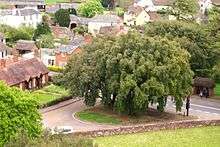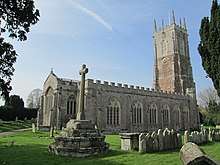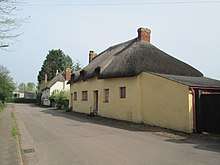Broadclyst
Broadclyst is a village and civil parish in the East Devon local government district. It lies approximately 5 miles northeast of the city of Exeter, Devon, England, on the B3181. In 2001 its population was 2,830, reducing at the 2011 Census to 1,467.[1] An electoral ward with the same name exists whose population at the above census was 4,842.[2]

Parish church

Its church is 15th century, with an ancient cross. It has many battlements, pinnacles and gargoyles. According to the Anglo-Saxon Chronicle, in the year 1001, the manor at Broad Clyst was burned down by Danish invaders.[3]
Communications
On 16 October 1975, the nearby M5 opened and the A38 road that ran through the village became quiet, later being reclassified B3181.
Broadclyst railway station was opened in 1860 by the London and South Western Railway on its London Waterloo to Exeter line. It closed in 1966 but some of the buildings remain.[4]
Amenities and historic buildings
Killerton House, a National Trust property, is close to the village, as well as Broadclyst Cricket Club, which play within the gardens of Killerton House. The village pubs are the Red Lion Inn and the New Inn on Whimple Road. The Clyst Vale Community College secondary school is located in Dog Village.
Churchill Farm is the origin of the name of the Churchill family.[5]
Marker's Cottage

Marker's Cottage, in the Townend part of the village, is a Grade II* listed building and a National Trust property, named after Sarah Marker, its resident about 200 years ago. It has cob walls and a thatched roof, and was built in the 15th century with later alterations. Oak screens between the hall and parlour are painted with images, dated stylistically 1470–1510; there is a large stair turret, built in the 17th century.[6][7]
Twinning
Broadclyst has been twinned since 2006 with the French village of Plobannalec-Lesconil, in southern Finistère in Brittany, which was formalized in 2010.
References
- "Parish population 2011". Retrieved 23 February 2015.
- "ward population 2011". Retrieved 23 February 2015.
- Swanton, Michael (ed.). The Anglo-Saxon Chronicle. p. 132.
- Oakley, Mike (2007). Devon Railway Stations. Wimbourne: The Dovecote Press. ISBN 978-1-904349-55-6.
- Rowse, A. L. The Early Churchills
- Historic England. "Marker's Cottage (1170878)". National Heritage List for England. Retrieved 30 April 2019.
- "Behind the door of Marker's" The National Trust. Retrieved 30 April 2019.
External links
| Wikimedia Commons has media related to Broadclyst. |